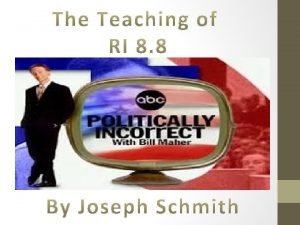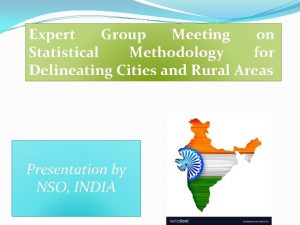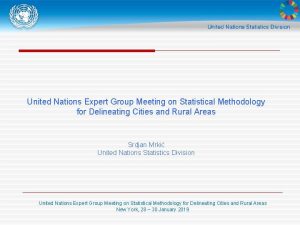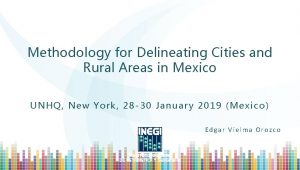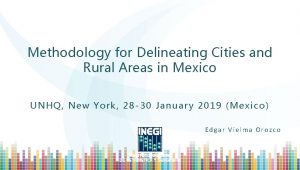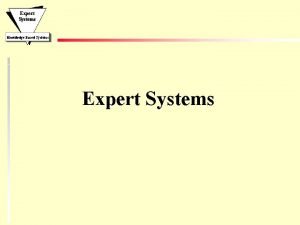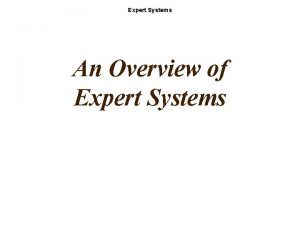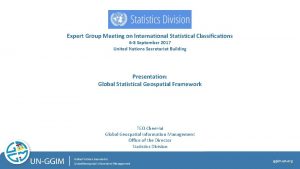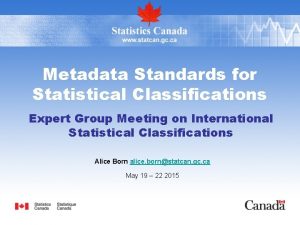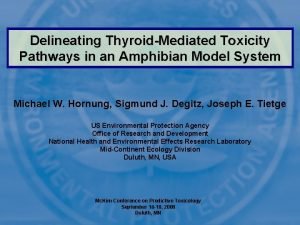Expert Group Meeting on Statistical Methodology for Delineating

















- Slides: 17

Expert Group Meeting on Statistical Methodology for Delineating Cities and Rural Areas January, 2019

Statistical Methodology for Delineating Cities and Rural Areas 1. National context 2. Application of the methodology 3. Main findings 4. Conclusions ·

1. National context ·

National Context Ecuador Population 2018: 17’ 023. 408 (projection) 50. 50% 49. 50% Population 2010: 15’ 012. 228 (last census) Surface: 283. 560 km² Political Administrative Division Provinces Cantons 24 urban 221 Parishes rural 803 ·

Application of the methodology Exploratory exercise ·

Application of the methodology Ecuador: An exploratory exercise In Ecuador, density and geographic location are not considered in order to classify the degrees of urbanization. Main cities are identified in statistical operations only with representativeness purposes. Urban area More than 2. 000 inhabitants Rural area Less than 2. 000 inhabitants Andean Community of Nations criteria (CAN) Political Administrative Division is used to produce statistics Cantons’ capital are considered urban areas The rest of the canton is rural. ·

Application of the methodology Ecuador: An exploratory exercise Cantón La Libertad • We don’t have information about the localization of population in order to identify concentration of population in specific areas (main limitation). • Population census data, surface data and Political Administrative Division of 2010 • Assumption: population density of each grid cells of 1 km 2 is the same in each local unit (parishes). • Using density, population and contiguity we identified urban centres, urban clusters and rural cells (level 1 of the degree of urbanization) • We group up the population of urban centres, urban clusters and rural cells in a canton in order to classify and apply level 2 ·

Application of the methodology Ecuador: An exploratory exercise Quito and Rumiñahui Cities 1701 Quito Total pop. Canton 2’ 735. 987 Urban Centre pop. 2’ 264. 676 Percentage of population in one or more urban centre 83% Urban centers identified in Canton Quito: • • • Quito Calderón Conocoto Cumbaya Llano Chico ·

Application of the methodology Ecuador: An exploratory exercise Town and Suburbs Guayaquil 0901 Guayaquil Total pop. Canton 2’ 698. 077 Urban Cluster pop. 2’ 629. 496 Percentage of population in urban cluster 97% Guayaquil has been identified as a Town and Suburb ·

Application of the methodology Ecuador: An exploratory exercise Morona Rural areas 1401 Morona Total pop. Canton 56. 679 Urban Cluster pop. 26. 409 Percentage of population in urban cluster 47% Morona has been identified as rural area, as it has one urban cluster (Macas) with less than 50% of population of the canton ·

Main findings ·

Main findings Ecuador Main cities (national criteria) defined as town and suburbs Main cities capture • • • Quito Cuenca Ambato Esmeraldas Riobamba • • • Guayaquil Machala Santo Domingo Manta Loja Parishes defined as urban centres • • Calderón Conocoto Sangolquí La Libertad ·

Main findings Ecuador Degree of urbanization Urban Centre Urban area (national definition) Urban Cluster Urban area (national definition) Rural Cells Rural area (national definition) Urban area (national definition) Total Number of parishes 9 9 85 85 930 276 654 1024 930 parishes were defined as rural cells, but using the national definition, only 276 of them were classified as rural areas (29. 68%). In addition, the parishes classified as urban centres (9) and urban clusters (85) match with the national definition of urban area ·

Conclusions ·

Conclusions Ecuador Availability of information about population´s location per km 2 is needed. This is the main limitation for the application of the degree of urbanisation level 1 and level 2 Our main sources are population census and their projections, which are updated every 10 years. Ecuador does not have official definitions for cities, town and suburbs, this is why comparisons where made based on main cities identified in specific statistical operations (Price consumer index) A strict application of the methodology was not possible. ·

Conclusions Ecuador We have not developed official definitions for the economic/functional extent of cities and information commuting data at the local level is scarse. The method is very useful, however its adaptation represent some challenges at national level, but it also offers an important opportunity to develop definitions that do not exist at the moment. Especially in the next round of population Census (2020) The methodology would probably implies changes in definition of areas for sampling design of national surveys. Furthermore, at the present Political Administrative Division is used in most of the official statistics, it would be important to work with producers of information at local level in order to apply the methodology proposed. ·

Ma. Alexandra Suasnavas S. Coordinator of Statistical Planning, Norms and quality alexandra_suasnavas@inec. gob. ec
 Delineate argument
Delineate argument Today meeting or today's meeting
Today meeting or today's meeting Meeting objective
Meeting objective What is meeting and types of meeting
What is meeting and types of meeting Types of meeting
Types of meeting Vat expert
Vat expert Advisory expert group on national accounts
Advisory expert group on national accounts Jlab user group meeting
Jlab user group meeting Jefferson lab sol
Jefferson lab sol Kontinuitetshantering
Kontinuitetshantering Novell typiska drag
Novell typiska drag Tack för att ni lyssnade bild
Tack för att ni lyssnade bild Vad står k.r.å.k.a.n för
Vad står k.r.å.k.a.n för Shingelfrisyren
Shingelfrisyren En lathund för arbete med kontinuitetshantering
En lathund för arbete med kontinuitetshantering Särskild löneskatt för pensionskostnader
Särskild löneskatt för pensionskostnader Personlig tidbok
Personlig tidbok Sura för anatom
Sura för anatom
